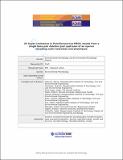UV hyper-resistance in Prochlorococcus MED4 results from a single base pair deletion just upstream of an operon encoding nudix hydrolase and photolyase
Author(s)
Holmbeck, Brianne M.; Osburne, Marcia; Frias-Lopez, Jorge; Huang, Katherine H.; Chisholm, Sallie (Penny); Kelly, Libusha; Coe, Allison; Steen, Robert; Waraska, Kristin; Gagne, Andrew; ... Show more Show less
DownloadOsburne et al 2010 final resubmission.pdf (344.9Kb)
OPEN_ACCESS_POLICY
Open Access Policy
Creative Commons Attribution-Noncommercial-Share Alike
Terms of use
Metadata
Show full item recordAbstract
Exposure to solar radiation can cause mortality in natural communities of pico-phytoplankton, both at the surface and to a depth of at least 30 m. DNA damage is a significant cause of death, mainly due to cyclobutane pyrimidine dimer formation, which can be lethal if not repaired. While developing a UV mutagenesis protocol for the marine cyanobacterium Prochlorococcus, we isolated a UV-hyper-resistant variant of high light-adapted strain MED4. The hyper-resistant strain was constitutively upregulated for expression of the mutT-phrB operon, encoding nudix hydrolase and photolyase, both of which are involved in repair of DNA damage that can be caused by UV light. Photolyase (PhrB) breaks pyrimidine dimers typically caused by UV exposure, using energy from visible light in the process known as photoreactivation. Nudix hydrolase (MutT) hydrolyses 8-oxo-dGTP, an aberrant form of GTP that results from oxidizing conditions, including UV radiation, thus impeding mispairing and mutagenesis by preventing incorporation of the aberrant form into DNA. These processes are error-free, in contrast to error-prone SOS dark repair systems that are widespread in bacteria. The UV-hyper-resistant strain contained only a single mutation: a 1 bp deletion in the intergenic region directly upstream of the mutT-phrB operon. Two subsequent enrichments for MED4 UV-hyper-resistant strains from MED4 wild-type cultures gave rise to strains containing this same 1 bp deletion, affirming its connection to the hyper-resistant phenotype. These results have implications for Prochlorococcus DNA repair mechanisms, genome stability and possibly lysogeny.
Date issued
2010-07Department
Massachusetts Institute of Technology. Department of Civil and Environmental EngineeringJournal
ENVIRONMENTAL MICROBIOLOGY
Publisher
Society for Applied Microbiology / Blackwell
Citation
Osburne, Marcia S. et al. “UV hyper-resistance in Prochlorococcus MED4 results from a single base pair deletion just upstream of an operon encoding nudix hydrolase and photolyase.” Environmental Microbiology 12.7 (2010): 1978-1988. © 2010 Society for Applied Microbiology and Blackwell Publishing Ltd
Version: Original manuscript
ISSN
1462-2920
1462-2912